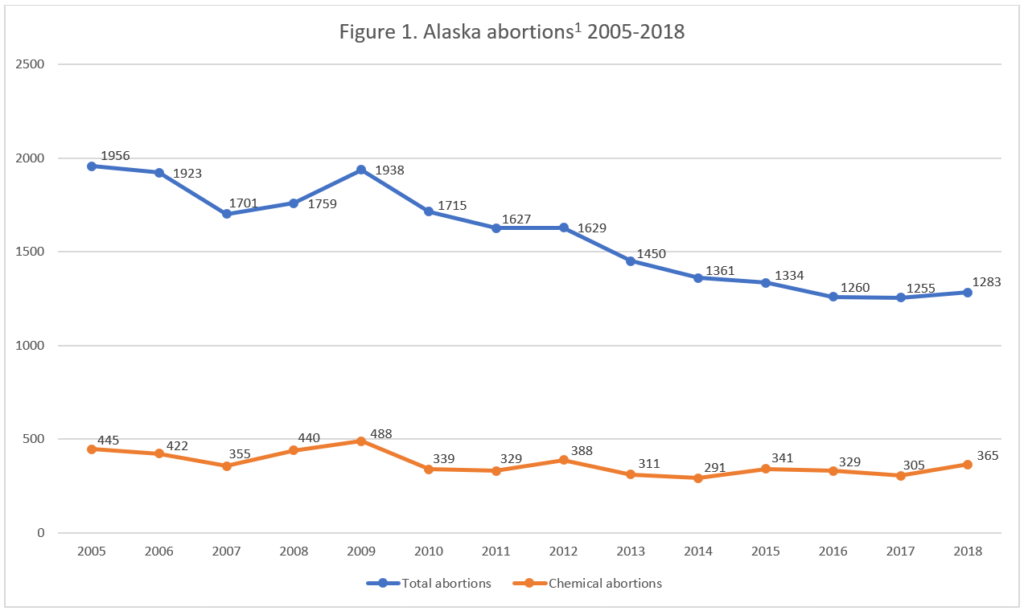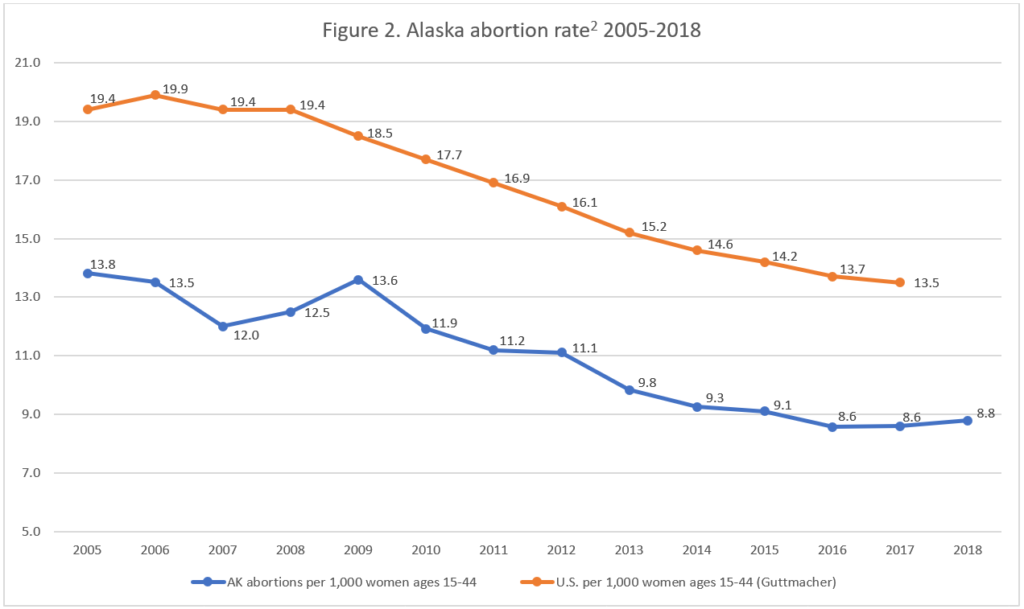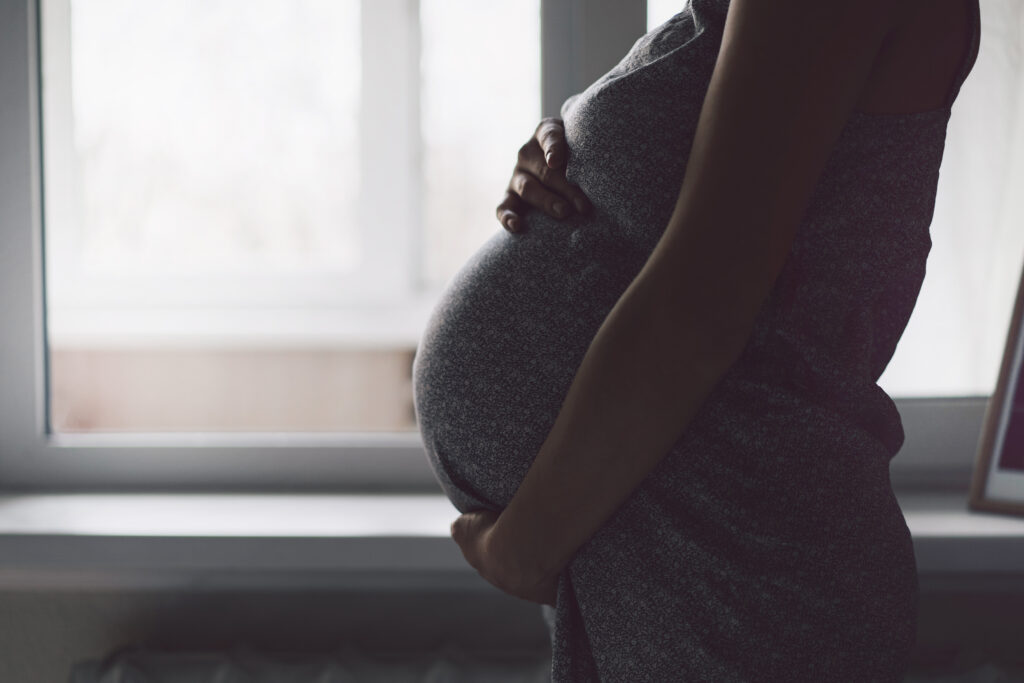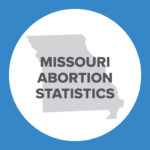Abortion Reporting: Alaska (2018)
Alaska’s 2018 abortion report, published online in February of 2019, shows that abortions increased in the state for the first time in six years. Alaska is one of the first states to publish its annual abortion report every year.
Changes in Alaska Abortions, 2017-2018

*Information on Alaska market share is not publicly available.
There were 1,283 abortions reported in Alaska in 2018 (Fig. 1), an increase of two percent from the previous year but a drop of 29 percent since 2003, the first year in which Alaska’s abortion report was made available online. Chemical abortions jumped by almost 20 percent from 2017 to 2018 and by nine percent from 2003. A relatively low number of chemical abortions are reported in Alaska (365 in 2018), and chemical abortion totals fluctuate from year to year, but chemical abortions as a percentage of total abortions have been trending upward since 2003. In 2018, chemical abortions made up 28 percent of all abortions reported in Alaska, compared to 19 percent in 2003. CLI estimates that Alaska’s abortion rate increased slightly from 8.6 in 2017 to 8.8 in 2018 (Fig. 2).
State Report Summary
The vast majority (98 percent) of the abortions reported in Alaska were performed on Alaska residents. Seventeen of the abortions were on women from other states or countries, making up a little over one percent of the total, and an additional two abortions were performed on women of unknown residency. As in other states, women in their twenties made up the majority at 56 percent, followed by women in their thirties at 28 percent and women age 19 or younger at 12 percent. Women in their forties constituted the smallest age category, undergoing three percent of the abortions reported in Alaska.
More than three-quarters of the abortions (76 percent) were performed on unmarried women. Twenty-one percent were performed on married women, and two percent were performed on women of unknown marital status. More than half of the women had already experienced a live birth. Nineteen percent had one previous live birth, and 35 percent had two or more. Forty-five percent had never had a live birth. Sixty-five percent of the women had not had an abortion before, while 22 percent had one prior abortion and 13 percent had more than one.
Just over half the abortions were performed on white women (52 percent). Nineteen percent were performed on American Indian or Alaska Native women, and eight percent were performed on Asian or Pacific Islander women. Six percent of the abortions were performed on black women. Twelve percent of the abortions were performed on women of other or multiple races and three percent on women of unknown race. CLI estimates that in Alaska in 2018, black women had the highest abortion rate at 11.3 abortions per 1,000 women of childbearing age, while Asian and Pacific Islander women had the lowest abortion rate at 6.8 abortions per 1,000 women of childbearing age.
Sixty-three percent of the abortions reported in Alaska were performed at or before eight weeks of gestation. Twenty-nine percent were performed between nine and 12 weeks, and eight percent were performed between 13 and 16 weeks. One abortion was performed between 17 and 20 weeks, and two abortions were performed at unknown gestational ages. No abortions were reported at 21 weeks or later. In 2018, three abortions were performed because the babies had been diagnosed as having congenital anomalies.
Medicaid and Abortion
State Medicaid funded a smaller percentage of abortions in 2018 than in the year before. Forty-five percent of the abortions reported in 2018 in Alaska were covered by Medicaid, compared to 51 percent in 2017, a difference of 56 abortions. Alaska’s 2018 report reflects updated categories of payment methods, which could account for the change.
In 2018, eight percent of the abortions were covered by insurance, up from six percent the year before. All plans offered on Alaska’s health insurance exchange in 2018 covered elective abortion. Forty percent of the abortions reported in Alaska were self-pay, and six percent were funded using a different method of payment.
In 2013, Alaska passed a law that limited Medicaid funding to abortions performed due to rape, incest, or risk to the life of the mother. The law was blocked by a court order in 2015, allowing state Medicaid to begin covering elective abortions. In February 2018, the Alaska Supreme Court upheld the lower court decision, preventing the funding limitation from going into effect.
State Ranking
Once again, Alaska was the first state to make its full annual abortion report available online. However, in a 2016 study by the Charlotte Lozier Institute, Alaska’s abortion reporting was ranked at just 21st best out of the 50 states, New York City, and the District of Columbia. Alaska’s 2018 abortion report already shows improvement: the state provided an explanation for the discrepancy between abortion totals in the 2017 report and earlier reports.1 Still, Alaska could improve its reporting by including information that other states do, such as complications resulting from abortion or women’s reasons for abortion. The speed shown by Alaska in releasing its report is a model for other states that can take up to a year or more to compile and release these important vital statistics.
- Alaska’s 2018 report states: “Please note that induced termination reports published by the Section in 2015, 2016, and 2017 erroneously included 157 induced terminations from Alaska resident women that occurred in Washington as part of the 2014 estimates. These records are no longer counted, so 2014 totals may differ from totals published between 2015 and 2017.” The estimated abortion rate for 2014 published here does not match the rate in earlier CLI reports due to this revised abortion total.
- Starting with the 2018 abortion reports, rates are calculated by the Charlotte Lozier Institute to allow for easier state-to-state and year-to-year comparisons. Rates were calculated by CLI using population estimates from the United States Census Bureau. The rates were calculated using the following formula: (total number of abortions performed in Alaska ÷ number of resident women ages 15-44) x 1,000. Rates differ slightly from previous CLI articles due to revised population estimates. This chart was updated in October 2019 to reflect the latest national abortion rates estimated by the Guttmacher Institute.
Click here to view reporting from:20242023202220212020201920172016




























